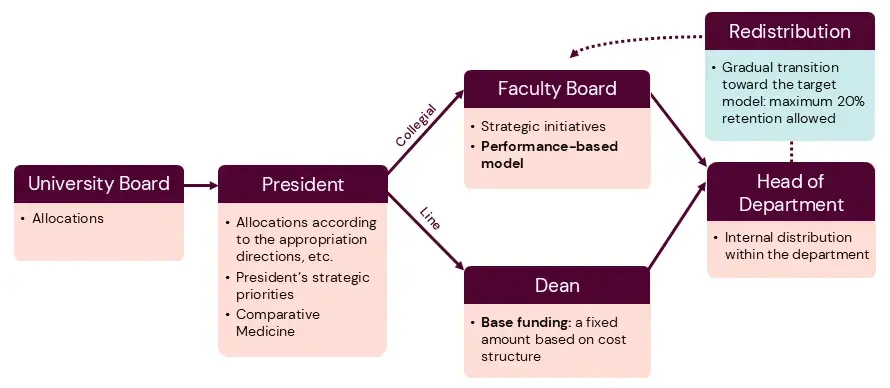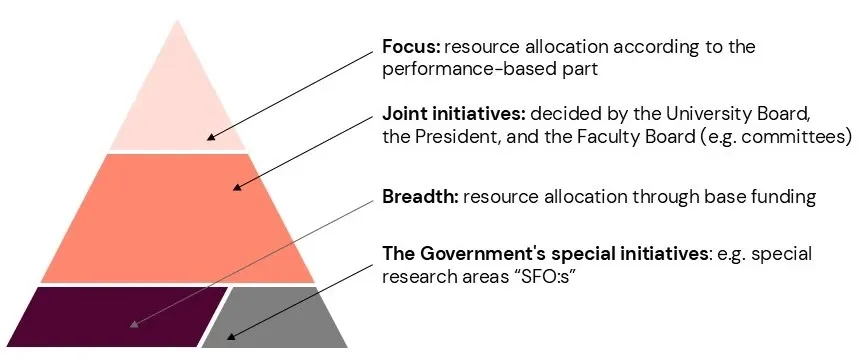KI's allocation of research funding
This page describes how the government grant for research and education at the doctoral level is allocated at KI. The grant accounts for approximately 20 per cent of KI's total income and is allocated through decisions made by both the President and the Faculty Board.
The government grant for research and education at the doctoral level, known as the research grant, comes from the government and is decided in the annual appropriation letter. Government grants must be used for operations and consumed in the same year they are paid out.
The purpose of the research grant is, among other things, to:
- ensure high-quality research and postgraduate education with high societal relevance
- strengthen the link between education and research
- provide long-term and stable funding for infrastructure, doctoral education and recruitment
- enable strategic investments in priority areas
- contribute to KI being an internationally leading medical university.
Decision-making process for the allocation of grants
KI's allocation of government grants is based on a delegation system. The University Board decides annually on KI's planning conditions. Based on this decision, the President decides on the allocation of the Faculty Board's budget and other allocations within his/her delegation.
The Faculty Board decides on further allocation to committees, boards and other central bodies, which in turn allocate government grants to departments and units. The Faculty Board also allocates strategic funds directly to the departments.
The allocation of basic funding is decided by the dean and heads of department.

A model for long-term stability
From 2026, a model for the allocation of research funding will be implemented with the aim of providing long-term and stable funding, creating scope for strategic initiatives and strengthening all of KI's research – from breadth to excellence. In the previous model, there were rent subsidies at the consistory level, but these have now been removed, freeing up funds that are now being channelled into the new model.

Base funding is based on each department's total turnover. It aims to provide all departments with stable and predictable funding so that activities can be planned for the long term. Deans and heads of department decide on the distribution and joint priorities within each campus group. Follow-up is carried out annually, linked to the operational planning process, among other things.
Joint initiatives are decided by the University Board, the President or the Faculty Board, depending on the type and scope of the initiative, in order to enable strategic investments and priorities that benefit the whole of KI, such as research infrastructure. Funds are allocated based on identified needs and priorities at university level and in accordance with the delegation order described above. Follow-up takes place in dialogue with the activities concerned.
The performance-based model aims to reward high-quality research with international impact. Funds are allocated based on two indicators: 50% external grants and 50% bibliometrics (publications and citations). These indicators are monitored and can be calibrated annually by the faculty board.
Annual follow-up of distribution
Follow-up of the model's overall outcome takes place in dialogue with the University Management. Reviews and follow-ups are carried out annually for the various parts of the model, and adjustments can be made if necessary, including calibration of indicators.
The Government grant shall be used in the activities during the year in which it is distributed. If there is money left at the end of the year, it becomes administrative capital and can be reallocated by the Faculty Board according to the performance-based model.
The budget process as an annual cycle
Government grants are preliminary and may be affected by amendment decisions during the current year. Work on the budget for the coming year begins in March and continues throughout the year with the following activities:
March: The Faculty Board decides on preliminary budget frameworks for the following year for the committees and the Infrastructure Board.
June: The committees and the Infrastructure Board present budget proposals to the Faculty Board.
June-October: The Faculty Board works continuously to prepare next year's budget.
September: The government's budget proposal for the following year is presented. It provides indications of what the regulatory letter for the coming year will look like.
October: The University Board decides on the planning conditions for the following year. The President and the Faculty Board decide on their budgets for the following year.
December: In the first week of December, the departments receive preliminary information about the funds allocated for the coming year. At the end of December, KI receives its appropriation directions.
January: Financial statements for the previous year. Handling of any reallocations of government capital and special initiatives begins.
January-March: Updates on preliminary notifications of allocated funds for the current year to the departments.
By April: Reallocated funds from the previous year are made available for operations.
Results for previous years
Results are monitored and analysed in relevant forums on an ongoing basis throughout the year, including in connection with operational planning.
